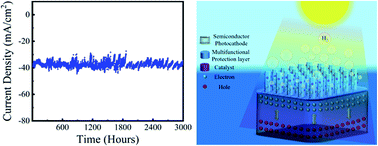Long-term stability studies of a semiconductor photoelectrode in three-electrode configuration†
Abstract
Improving the stability of semiconductor materials is one of the major challenges for sustainable and economic photoelectrochemical water splitting. N-terminated GaN nanostructures have emerged as a practical protective layer for conventional high efficiency but unstable Si and III–V photoelectrodes due to their near-perfect conduction band-alignment, which enables efficient extraction of photo-generated electrons, and N-terminated surfaces, which protects against chemical and photo-corrosion. Here, we demonstrate that Pt-decorated GaN nanostructures on an n+–p Si photocathode can exhibit an ultrahigh stability of 3000 h (i.e., over 500 days for usable sunlight ∼5.5 h per day) at a large photocurrent density (>35 mA cm−2) in three-electrode configuration under AM 1.5G one-sun illumination. The measured applied bias photon-to-current efficiency of 11.9%, with an excellent onset potential of ∼0.56 V vs. RHE, is one of the highest values reported for a Si photocathode under AM 1.5G one-sun illumination. This study provides a paradigm shift for the design and development of semiconductor photoelectrodes for PEC water splitting: stability is no longer limited by the light absorber, but rather by co-catalyst particles.



 Please wait while we load your content...
Please wait while we load your content...
